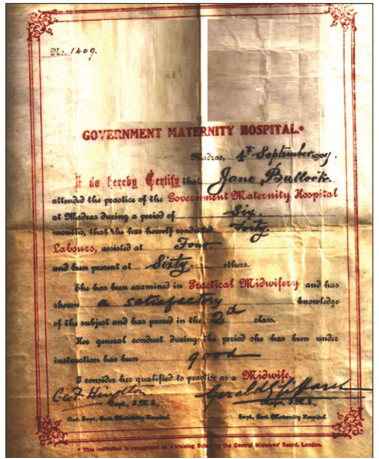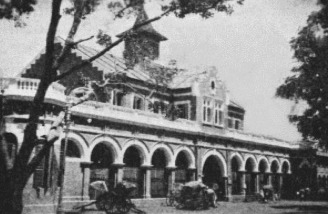Registered with the Registrar of Newspapers for India under R.N.I 53640/91
Uncategorized
Medicare for women, in old Madras
by Ramya Raman and Anantanarayanan Raman
(Continued from last fortnight)
The Royal Victoria Hospital for Caste and Gosha Women (RVH) serviced the women of Madras coming from varied social backgrounds. At one stage Mary Pailthorpe, an MBBS degree holder from the Newnham College, University of Cambridge, UK, who had trained at the Royal Free Hospital, Camden, England, joined Scharlieb at RVH as Resident Medical Officer in 1885. She was selected in Britain to supervise the Mission Hospital in Banares (Varanasi), but was assigned to work at RVH. For personal reasons, the Scharliebs returned to England permanently in 1887. Soon after Mary Scharlieb qualified for an MD and MS through London Medical School for Women (LMSW), and later became the personal physician to the Queen.
While in Madras, Scharlieb had a busy practice. She argued for a feminine line of communication: flowing from a woman medical professional to the mother and through her to her children. She lectured on midwifery, gynaecology, and children’s illnesses at MMC until her return to London. Scharlieb’s books, written after her return to England, reinforced the importance of personal hygiene for girls and reproductive health in women.
The RVH established under the superintendence of Scharlieb in Moore’s Garden underwent major changes in the following years. Anna Webster, along with K. Bashyam Iyengar, R. Raghunatha Rao, Ananda Gajapati Raju (Raja of Vizianagaram), S. Muthuswamy Iyer, G.K. Yachendra (Raja of Venkatagiri) and Savalai Ramaswamy Mudaliar played a major role in developing the RVH. The Government of Madras donated a block of land and offered Rs 10,000 towards the establishment of this hospital. It relocated to Triplicane (a suburb of Madras along the coast) in 1890. The main building of this new precinct was constructed from a generous grant by Yachendra. The Government of Madras took over the management of this hospital in April 1921. It was renamed the Kasturba Gandhi Hospital for Women in 1948. The hospital gained reputation through the sustained efforts of many women medical practitioners, notably Mary Beadon, Hilda Mary Lazarus and E. Madhuram in later years. It presently functions as the ‘Institute for Social Obstetrics and Kasturba Gandhi Hospital for Women and Children’. The General Hospital in Madras (MGH), the oldest Western medical hospital in India, functioned as a military facility within Fort St. George from 1664, which moved to its present location in Périamét (Narimédu, Hog Hill) in 1763. Since the MGH was not accessible to Indians at that time, they received treatment at the Native Hospital (NH) in Purasawalkam both as out- and in-patients. This hospital included modest lying-in facilities to meet maternity needs, further to meeting other medical needs. The NH was managed by a committee of non-Indian residents of Madras. In 1903, the Kanji Thotti Hospital (1799) of Royapuram, morphed into the Auxiliary Medical School (AMS). The Lady Willingdon Medical School for Women was started in Royapuram in 1923 and was merged with the AMS. This complex grew into the Stanley Medical College & Hospital in 1938.
Midwives were trained in this precinct from 1844. A list of names of 80 mid-wives trained in the NH between 1844 and 1864 is available. By 1871, this less formal training gradually transformed into a formal training programme with the establishment of a midwife training school. The maternity ward at the NH was renamed ‘Maternity Hospital’ (MH) in 1881 and relocated to Pantheon Road, close to Egmore train station in 1905–1908, where it presently exists. The new MH precinct was built through public donation. The Government of Madras paid staff salaries and met food expenses towards patients.
The MH during the superintendence of Gerald Giffard (Superintendent, 1905–1917) issued qualifying certificates to midwife trainees after six months of training.
 A certificate issued to a qualified midwife by the Maternity Hospital, Egmore, Madras, signed by G. Giffard and C.G.F. Hingston, Superintendent and Assistant Superintendent respectively, dated 4 September 1909.
A certificate issued to a qualified midwife by the Maternity Hospital, Egmore, Madras, signed by G. Giffard and C.G.F. Hingston, Superintendent and Assistant Superintendent respectively, dated 4 September 1909.
The certificate alongside clarifies that the qualified midwife (Jane Bullock) had conducted 40 labours, assisted in 4 and observed 60, thus providing an idea of the level and quality of training provided. The Government of Madras managed to get a reciprocal registration in the training of nurses between the UK and Madras in 1928.
The frontage of the Pantheon Road MH includes a gable façade and an asymmetrical arcade topped by an ornate balustrade and a ‘Travancore’ style tower. From 1881, the MH became a Government-managed facility. In the next two decades, it expanded to accommodate 150 in patients. By 1882, MMC offered intense training to medical students at the MH precinct through a 9-month-long integrated course in midwifery and diseases of women and children, which was the predecessor of the Diploma in Gynaecology and Obstetrics, formally offered from 1930. By the 1900s, the MH further expanded with scope for 140 additional beds. William Thompson superintended this hospital between 1848 and 1851.

Frontage of the Madras Maternity Hospital (1940s?).
James Shaw, the first professor of midwifery at MMC, superintended the maternity ward of the NH between 1844 and 1864. Arthur Branfoot (Superintendent, 1879–1898) is indicated to have attended to the delivery of the baby of Supalayat (1859–1925), Queen of Burma, who was imprisoned by the British Government and stationed in Madras in 1886. Gerald Giffard constructed a separate teaching block, after whom the Giffard Block remains today.
This Pantheon Road building, when completed, was remarked to be resembling a female pelvis: the labour ward complex representing the sacrum, the lying-in wards representing the inlet, and the main-gate complex representing the inguinal ligaments reaching the pubic symphysis. Fourth-year students from medical colleges of far-off Lucknow, Lahore and Burma came to this hospital for a month-long training involving observation of obstetric procedures and hands-on experience in handling labour.
Arcot Lakshmanaswami Mudaliar, at the inauguration of the First All-India Obstetrics and Gynaecological Congress, presided over by Ida Scudder of Vellore, held in Madras in 1936, said:
‘… But Madras is proud, and justly so, of the place it occupies in the obstetric world of today and it is in no spirit of narrow provincialism that I venture to maintain that no other city in Indian could have claimed this honour with greater confidence and dignity. …’.
(To be continued next fortnight)

